- TableTalkAI
- Posts
- 🤖☕ AI, Expansion & Espresso: Rewriting the Restaurant Playbook 🤝❤️
🤖☕ AI, Expansion & Espresso: Rewriting the Restaurant Playbook 🤝❤️
AI in Restaurants: Efficiency, Personality, and the Next Competitive Edge
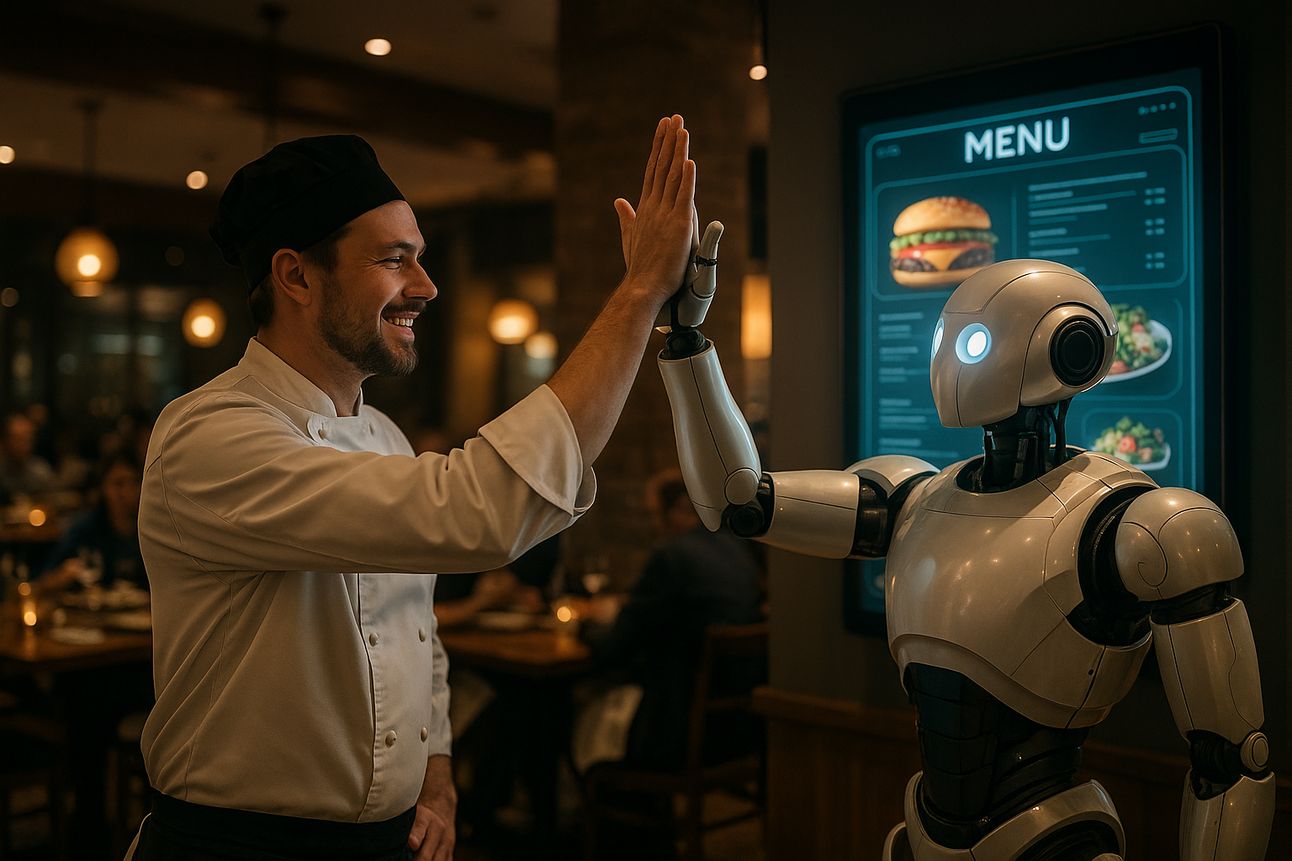
Learn AI in 5 minutes a day
This is the easiest way for a busy person wanting to learn AI in as little time as possible:
Sign up for The Rundown AI newsletter
They send you 5-minute email updates on the latest AI news and how to use it
You learn how to become 2x more productive by leveraging AI
Happy Friday, friends! I hope your week was caffeinated and prolific. My attorney/wife/co-author still cringes when I put promises in writing, but here goes: I promise this won’t be your typical industry update. Why? Because this week I’m channeling my inner tech geek and restaurateur in equal measure. The robots are clocking in, the data is pouring in, and the hospitality playbook is getting a rewrite in real time. Buckle up and let’s roll! 🚀
You see, I tried something a little mischievous the other day – I strolled into a busy Starbucks and asked the barista if she knew how to make a long-forgotten secret-menu Frappuccino (you know, one of those “double upside-down caramel mocha on a full moon” kind of orders). I expected a puzzled look or a frantic flip through a sticky recipe binder. Instead, she gave a confident smile, tapped on an iPad behind the counter, and in seconds cheerfully recited every ingredient and step. My jaw almost fell into my latte. Only later did I realize she wasn’t consulting her memory at all – she was getting help from Starbucks’ new AI-powered barista assistant, Green Dot Assist. Yes, folks, the coffee giant has a generative AI sidekick now, and it’s good. Baristas can ask this virtual assistant anything – how to make that seasonal drink, the recipe for a caramel macchiato, you name it – and get instant answers right on the in-store tablet. No more thumbing through manuals or guessing; the AI provides the info and poof, the human can get back to frothing milk and chatting with customers. Starbucks’ CTO calls it “a significant step” toward streamlining operations and reducing friction, freeing up staff to spend more time crafting beverages and connecting with customers. In other words, the Green Apron crew gets to focus on the hospitality part of the job, while the AI handles the encyclopedia of coffee knowledge in the background.
That experience got me thinking: AI isn’t some sci-fi concept on the distant horizon – it’s here and now, quietly (and not so quietly) changing how restaurants operate day to day. And it’s not just happening at Starbucks. All across the industry, from fast-casual burrito joints to classic sit-down restaurants, operators are weaving AI into their game plans. The goal? Make life easier for employees, make experiences better for guests, and do it all without losing that human touch that makes hospitality special. This week, let’s explore how AI is changing the operator’s playbook – from labor and site selection to service and guest experience – and what it means for those of us who live and breathe this business. Think of it as a tour of the tech-enhanced restaurant world: we’ll meet a hiring assistant named Ava Cado (yes, really), listen in on a clone of a BBQ owner taking phone orders in multiple languages, and peek at how big chains are using algorithms to forecast your next beer and burger order. Grab a snack (might I suggest some chips and binary dip?), and let’s dig in.
The Barista’s New Brain: Starbucks Brews Efficiency with AI ☕🤖
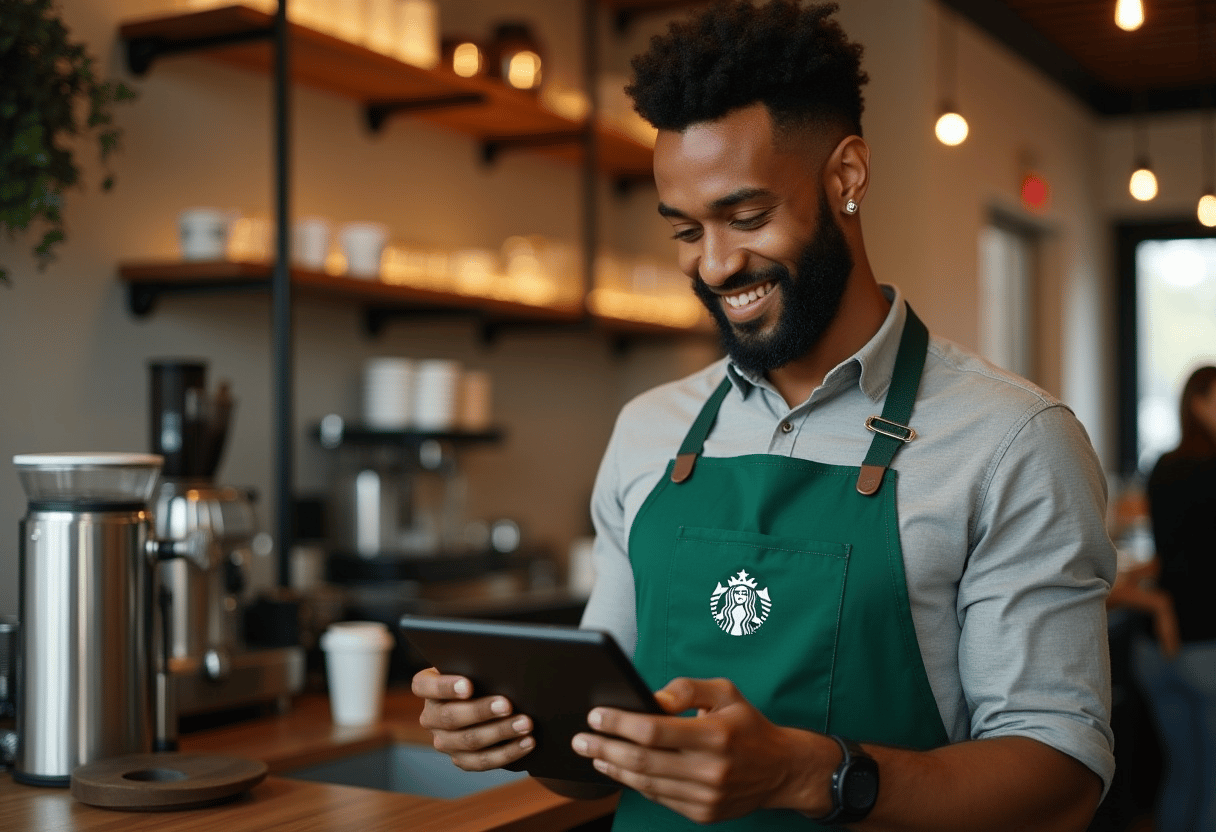
Starbucks isn’t just brewing coffee these days – it’s brewing up tech solutions to make its stores run smarter. Enter Green Dot Assist, the AI helper I encountered in my Frappuccino escapade. This generative AI virtual assistant is currently being piloted in 35 Starbucks stores, with plans to expand. The premise is simple but powerful: any barista can ask a question (via an in-store iPad) and get an instant, conversational answer. Forgot the recipe for the new seasonal drink? Green Dot’s got your back. Need to double-check how to troubleshoot the espresso machine’s cleaning cycle? Just ask the assistant instead of thumbing through a 100-page operations manual. Starbucks specifically built this tool to simplify access to info during the flow of work – no more stepping away to flip through binders or call the manager for help. One example: a partner (Starbucks-speak for employee) can get an ingredient reminder for that Pumpkin Cream Cold Brew in seconds, ensuring they make it exactly right for the guest in front of them.
All this might seem small – I mean, it’s just answering questions, right? But in a busy café, seconds matter and confidence is everything. By reducing little friction points (like “uhh, what goes in a Grande Caramel Ribbon Crunch?”), the AI is lightening the load on employees and making it easier for them to do what they do best: make great drinks and engage with customers. As Starbucks’ tech chief put it, the goal is to give partners more time to focus on crafting beverages and connecting with customers. That phrase is music to my ears – it’s tech in service of hospitality, not replacing it. So next time your barista instantly recalls a super-complicated order with a grin, don’t be too surprised if there’s a friendly AI whispering in their ear (or rather, on their tablet). The coffee juggernaut is betting that happier, less-stressed baristas will create happier customers in turn. And so far, it seems to be a win-win (with an extra shot of efficiency on top).
Opening Day, Every Day: Chipotle’s AI-Fueled Expansion 🌯🤖
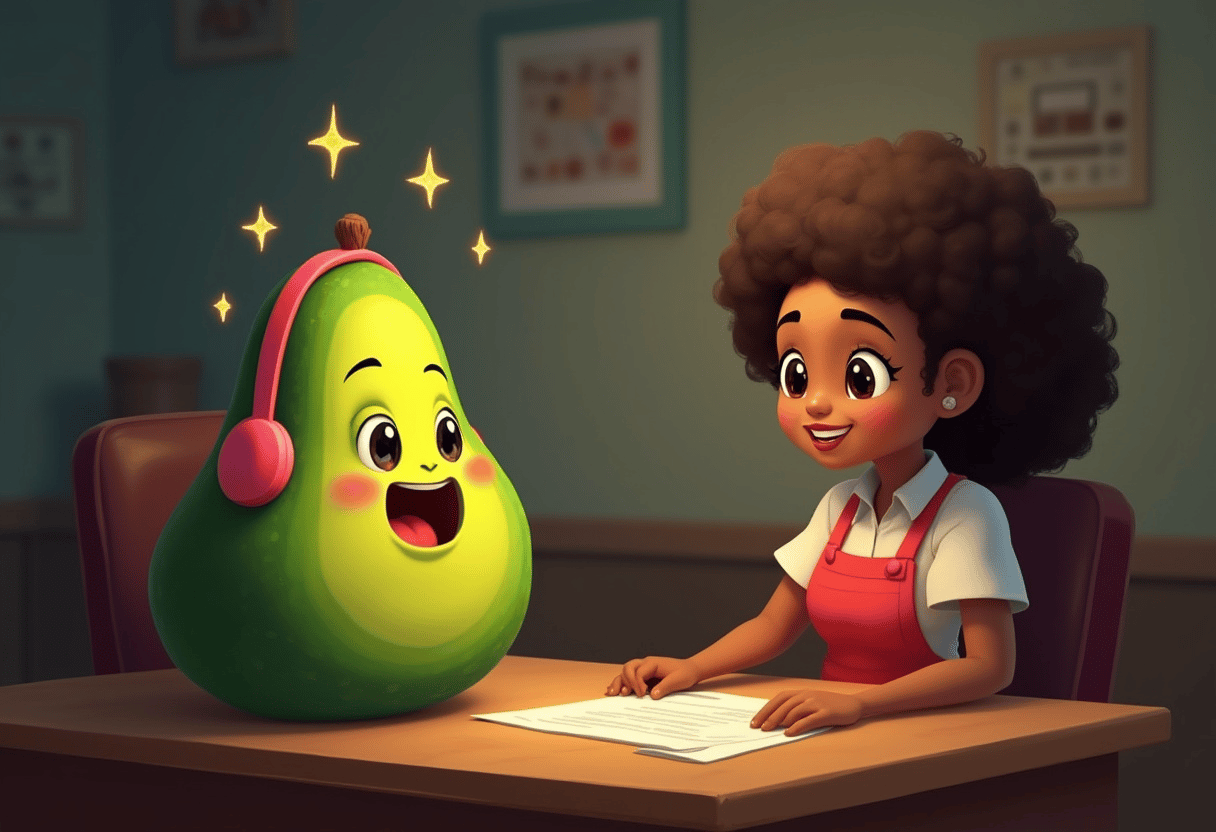
Meanwhile, over in burrito land, Chipotle is hitting the gas on expansion – and using AI like jet fuel. In fact, the chain’s leadership says they’re on track to open a new restaurant almost every 24 hours this year, thanks in part to AI-driven efficiencies. You read that right: a new Chipotle nearly every single day. If you’ve noticed Chipotle locations popping up faster than you can say “extra guac,” that’s no accident. At a recent summit, Chipotle’s COO (let’s call him the Chief Burrito Officer) credited artificial intelligence for helping the company grow at an “exponential rate”.
So what is AI doing for Chipotle, exactly? For starters, it’s tackling one of the toughest challenges in the biz: hiring and staffing. Chipotle built an AI hiring assistant with a punny name that made me smile – “Ava Cado.” 🥑 (Who says tech folks don’t have a sense of humor?) This virtual recruiter has been chatting with job applicants, scheduling interviews, and even sending offer letters, automating a ton of the tedious hiring steps. The result: Chipotle can staff new stores way faster than before. The AI-powered system cut the time to hire a new crew member by roughly 75%. What used to take weeks now might take just days – a crucial edge when you’re opening restaurants at breakneck speed. Chipotle’s CEO said these faster hiring times not only keep restaurants staffed, but ensure they snag the best talent available before someone else does. In an industry where good people are worth their weight in gold (or guacamole), that’s a big deal.
But Chipotle’s AI ambitions don’t stop at HR. They’re also using data models to remove waste and improve operations, all with an eye toward helping (not replacing) their workers. “We look to remove waste and expand or enhance the team member experience rather than replacing humans,” the COO emphasized. In practice, that can mean anything from AI that predicts exactly how much steak to prep for the lunch rush (so nobody’s scrambling or overcooking) to algorithms that fine-tune where the next Chipotle should open. Yes, site selection – that arcane mix of art and science – is getting a high-tech assist. By crunching data on demographics, traffic patterns, and burrito demand (I’d love to see that formula), AI can suggest promising new locations, helping Chipotle’s development team move with greater confidence and speed. It’s like having a digital real estate whisperer: “Build here, not there – trust me.” The faster they pick good sites, the faster those new stores can start rolling burritos.
And let’s not forget the guest-facing side: Chipotle is also deploying AI to make sure we keep coming back for more cilantro-lime rice. They’re leveraging it in their rewards program, using machine learning to personalize deals and offers for millions of loyalty members. If you always get a Sofritas bowl on Thursdays, don’t be shocked if an AI-powered email lands in your inbox one Wednesday night offering double points on – you guessed it – Sofritas bowls tomorrow. It’s tailored marketing at scale, and Chipotle says it’s seeing results in nudging customers to return.
Put it all together, and you have a portrait of a company using AI as a multi-tool: speeding up hiring, smarter site picks, more efficient kitchens, and personalized guest engagement. The grand promise is that by automating the grunt work and crunching the numbers, Chipotle’s people (both at HQ and in each restaurant) can focus more on quality, hospitality, and, as they like to say, the “total guest experience.” It’s a high-tech means to a very human-centric end. Of course, only time will tell if opening “a Chipotle a day” is actually sustainable, but one thing’s clear: the guacamole isn’t the only green stuff fueling Chipotle’s growth – there’s some AI code in the mix, too, and it’s working overtime.
Old Favorites, New Tricks: BJ’s, Cracker Barrel & Bloomin’ Go High-Tech 🍻📊

It’s not just the upstarts and fast-casual darlings hopping on the AI bandwagon. Some established full-service players – the kind of restaurants where Sunday supper or a Bloomin’ Onion might be more the vibe – are finding that AI can give them a much-needed efficiency boost. In a shaky economic climate, with costs up and guest counts in flux, brands like BJ’s Restaurants, Cracker Barrel, and Bloomin’ Brands (parent of Outback Steakhouse and more) are embracing tech to tighten operations and sweeten the guest experience. Think of it as grandma’s recipe with a dash of Silicon Valley spice. Here’s a taste:
Cracker Barrel (yes, your go-to highway pit stop for biscuits and nostalgia) has been testing AI-driven personalization in its rewards program. The result? A mid-single-digit lift in spending by loyalty members who get those tailored recommendations and perks. Not too shabby for suggesting Mama’s Pancake Breakfast to the folks who might actually bite. They’ve also rolled out an AI-powered traffic forecasting model to better predict customer flows, which in turn has improved their labor scheduling accuracy. Translation: they’re getting a better handle on when guests show up so they can staff appropriately and cut down on those dreaded wait times or idle staff hours. Win-win. Cracker Barrel’s CEO even noted their AI helps with guest relations – using tech to triage customer calls and speed up resolution when someone does need to talk to a real person. (Imagine calling with a complaint and the system already knows your order and issue before a human picks up – that kind of thing.) They’ve even dipped into machine learning for cybersecurity, proving that not even the country-fried crowd is immune to hacker worries. It’s a whole new world: one minute AI is recommending you a slice of Coca-Cola cake, the next it’s fending off cyber villains and rerouting your phone call.
Over at BJ’s Restaurants (the casual brewpub chain famous for deep-dish pizookies and craft beer), the focus is on using AI to see the future – or at least the next few weeks. BJ’s has been piloting an AI tool to forecast sales and optimize labor planning, and the early results have them excited. The AI crunches a bunch of historical data (sales, seasonality, local events, weather, you name it) and spits out predictions, which managers use to schedule the right number of staff at the right times. The company reported notable improvements in labor scheduling and even an uptick in guest satisfaction in the test markets. No more flying blind on how many servers to have on a Tuesday night – the algorithm has a pretty good guess. BJ’s new CEO, Lyle Tick, summed it up perfectly: it’s about having “team members in the right place at the right time to wow our guests.” That’s a hospitality mantra if I’ve ever heard one. In 2025, “wowing guests” might just take a little help from predictive analytics. BJ’s is now looking to broaden this AI scheduling system to more restaurants, since, hey, who doesn’t want to know the future (or at least avoid being short-staffed on wing night)?
For Bloomin’ Brands, the parent of Outback, Carrabba’s and more, AI is part of a broader tech makeover. They’ve been rolling out a new POS system across Outback Steakhouses to speed up customer feedback and incident reporting. Now, add AI to that mix: Bloomin’s leadership says they are leveraging AI tools to sift through all that incoming feedback and identify themes and issues for managers to address, quickly and efficiently. Instead of a regional manager reading 100 comment cards to spot a trend (“hey, people say our steaks were too salty last week in Denver”), an AI can parse the data in a flash and flag “hey, check the salt in Region 5, folks.” According to CEO Michael Spanos, this combo of real-time feedback plus AI insight gives managing partners actionable to-do lists, honing in on what needs fixing now. It’s like having a smart assistant that says, “Here’s the priority list for tonight’s shift meeting, boss.” All of this ties back to a simple idea: use tech to make the experience better for guests and employees alike. If a machine can crunch numbers or listen to feedback faster, managers can spend more time working with their teams or schmoozing tables in the dining room – you know, the human stuff.
None of these brands are abandoning their identity or going full robo-diner. Instead, they’re picking targeted use-cases where AI can shore up a weakness or amplify a strength. It’s an evolution born partly of necessity (leaner times call for smarter operations) and partly of opportunity (the tech is finally accessible enough to actually deliver results). One thing I love is that across these examples, the language of hospitality still comes through. We hear “wow our guests,” “make jobs easier for our team,” “deliver great guest experience” – not just cold, hard “optimize revenue per labor hour” (even if that’s in the mix quietly). The best operators know that if you take care of your people and your guests, the dollars generally follow. AI is just a new means to that end.
“The AI Will Take Your Order Now”: Voice Bots with Personality at the Drive-Thru 🎙️🤖
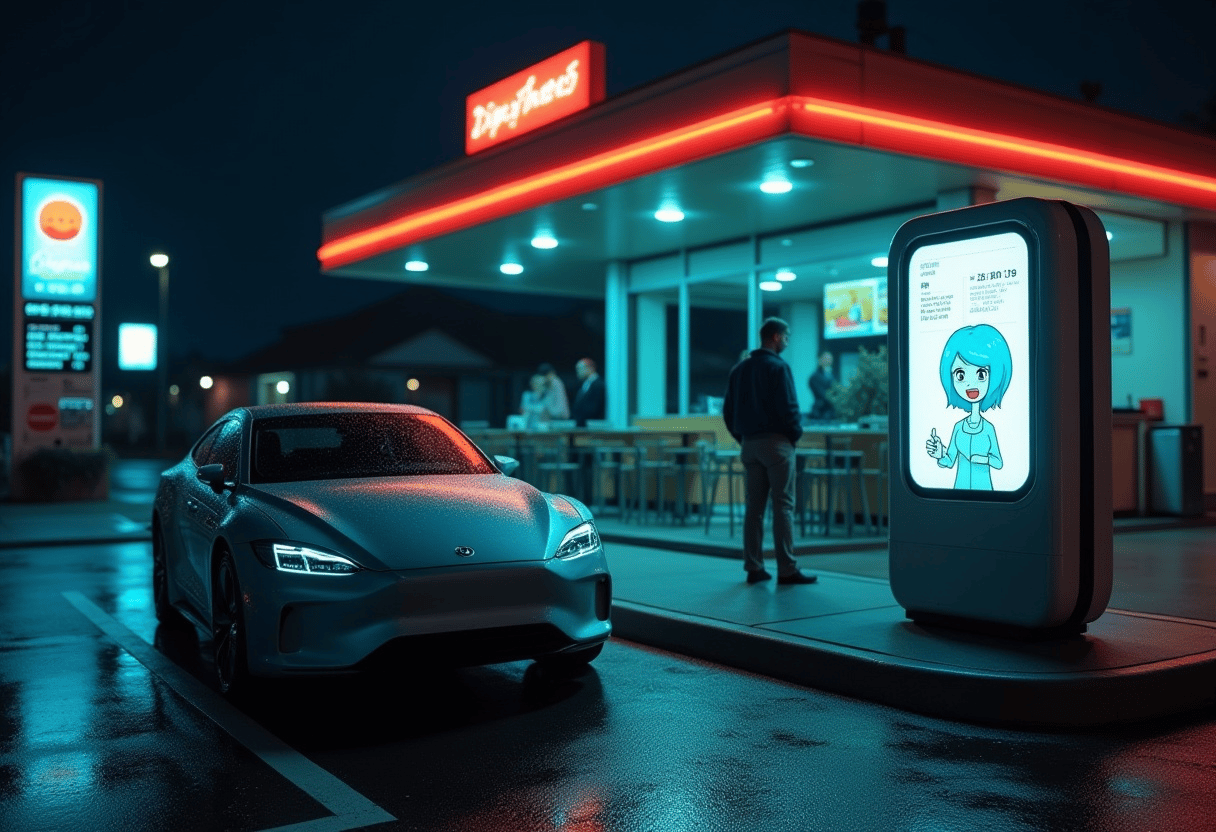
Now, let’s talk about one of the flashiest and most talked-about AI invasions in restaurants: the rise of the voice bots. You might have already met one – perhaps without even realizing it. Maybe you rolled up to a drive-thru speaker and the voice greeting you was just a little too perky (and never seemed to miss a beat). Or you phoned in a takeout order and wondered how the “host” on the line stayed unfailingly polite even when you changed your mind three times. There’s a good chance you were interacting with an AI order-taker. And in some cases, that voice isn’t a generic robot – it might be a cloned voice of the restaurant owner or mascot, designed to sound warm and familiar. Yes, we’ve entered the era of restaurant voice clones, and it’s equal parts amazing and eerie (in a fun way).
Case in point: my friend Shawn Walchef, who runs Cali BBQ out in San Diego, decided to clone himself (cue the sci-fi music). Or rather, he cloned his voice. He worked with a startup to create “ShawnAI,” a digital voice assistant that greets callers just like Shawn would – same friendly tone, same BBQ passion in every word. Call his restaurant and you’ll hear his voice saying hello and taking your order, even if Shawn is nowhere near the phone. Why go to these lengths? Shawn says he wanted every guest to get “the best hospitality experience possible,” and if he can’t personally answer every call, a voice clone of himself is the next best thing. It’s a wild concept – the owner can be seemingly omnipresent, chatting up customers like a friendly ghost in the machine. And guess what? Guests kinda love it. They get the feeling of that personal touch (regulars recognize his voice), and the AI on the other end is tirelessly polite, never puts you on hold, and always remembers to upsell a dessert 😅.
Shawn’s not the only one. Another restaurateur, Lee Kindell of Seattle’s MOTO Pizza, tried out a similar voice AI system (from a company called Palona AI) and got the surprise of his life. The AI not only cloned his voice to answer calls, it could seamlessly switch languages mid-call. One moment “LeeAI” was speaking English, and when a customer started chatting in Spanish, it swapped to Spanish on the fly in Lee’s voice, then even responded to a Mandarin speaker in Chinese. Lee said hearing his own voice fluently taking an order in Mandarin “blew me away”. Imagine that: you call for a pizza, and the owner greets you in your preferred language, without missing a beat. The tech behind this is trained on tons of real order scenarios, menu intricacies, and multi-lingual capabilities, all to make the experience feel natural. Palona AI boasts that it can handle highly customized orders (extra this, no that, substitutions – the usual chaos) and remember everything with real-time integration to the POS, so it never misses a modifier. Importantly, they program these voice bots to carry the brand’s tone – they shouldn’t sound like C-3PO droning on monotone; they aim to have the same pep and personality as a great human staffer. In other words, your AI order-taker could be as charming (or corny, if your brand is into dad jokes) as your best cashier on their best day.
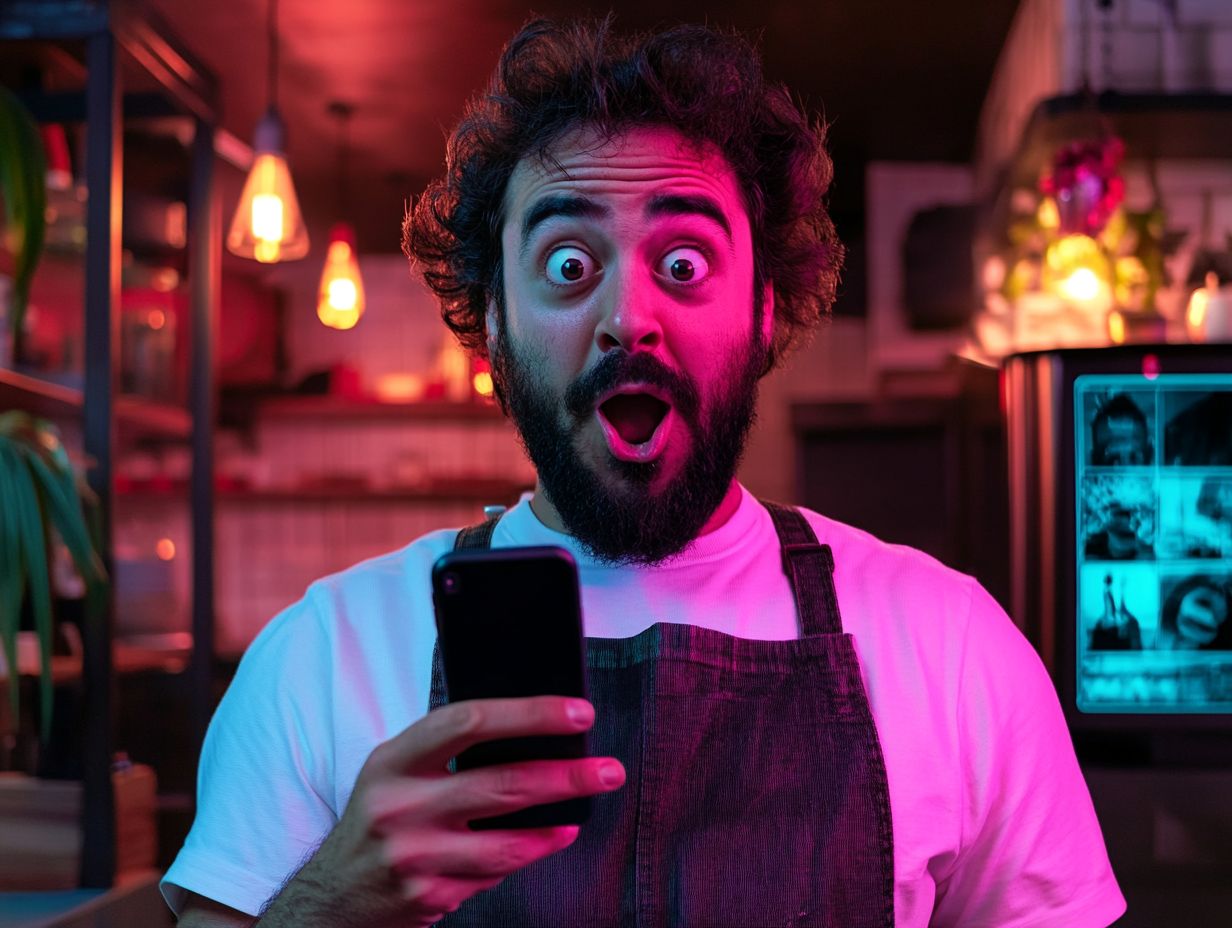
It’s not just indie operators dabbling here – big tech and big brands are racing to voice-enable ordering. At the National Restaurant Association show this year, you couldn’t turn a corner without hearing about some AI voice assistant for drive-thrus or phone orders. Even legacy POS companies are jumping in. One example that caught my eye: a voice AI firm called VoicePlug partnered with Qu POS (a modern point-of-sale platform) to make it plug-and-play for restaurants to add voice ordering. That means any restaurant using that POS system can basically say, “Sure, let’s have an AI answer our phones now,” without a massive IT project. It’s like Siri-for-burgers as a service. The promise these vendors are making reads like an operator’s wish list: 24/7 availability, no more missed calls, faster service, fewer errors, and happier guests. One system boldly advertises “Never Miss a Call Again,” offering a virtual phone assistant that can handle unlimited lines at once, take orders or reservations, and do it all with a remarkably human-like demeanor. Think of it as the world’s most patient, unflappable hostess – one who never has a bad day and never puts you on hold while she checks on table 7. In the drive-thru context, the AI voice is always ready to take your order the moment you’re ready, no “could you please wait a moment?” because it can multitask like a boss. And accuracy? These systems are trained on the entire menu, so they won’t mishear “no pickle” as “mo’ pickles” – a relief to pickle-haters everywhere. They even tend to upsell consistently (“Would you like to add chips and a drink?”) – basically doing the things a model employee would do, every time, without fail.
From an operator’s perspective, a lot of this sounds like a dream. Labor shortages, rising wages, high turnover – we’ve been singing those blues for years. Offloading some of the repetitive order-taking to AIs could indeed free up the scarce humans to tackle what humans do best: cooking the food, solving unique problems, and delivering that warm hospitality face-to-face. One voice tech company explicitly pitches it this way: let the AI handle the drive-thru chat or phone orders, so your staff can focus on service and kitchen work. In theory, everyone wins: guests get faster, friendly service without waiting; employees aren’t tied up answering phone calls during the dinner rush; and owners squeeze in more sales without adding labor cost. If it works as advertised, it’s like having an extra superstar employee who needs no breaks and can work the window, the phone, and the counter simultaneously. (It also never calls in sick, and won’t sneak fries from the bin – just sayin’.)
But – and of course there’s a but – no technology is perfect, especially not in its early days. We’ve all experienced the frustration of an automated system gone awry (I may or may not have yelled “human, please!” into my phone more than once). Early drive-thru AI pilots at some big brands had their hiccups, from misheard orders to comical misunderstandings (apparently AI struggles when a carful of kids screams their Happy Meal order – who’d have guessed?). So, there’s justified caution among operators. One seasoned industry observer quipped that last year everyone was talking about AI but much of it was vaporware; this year it’s about real results, and if your competitor uses AI to shave 30 seconds off each drive-thru order and upsell 10% more effectively, you’re going to notice – and feel pressure to follow suit. In other words, the arms race is on, but nobody wants to trip on the hype.
Restaurants will need to find the right balance here. It’s not a one-size-fits-all. A cozy family-run café might decide that a robotic voice answering the phone just doesn’t fit their personal touch, even if it’s efficient. Meanwhile, a fast-food chain manager might welcome our new robot overlords if they can crank out more orders in less time. Being an early adopter is great; being an early adapter – customizing the tech to your brand and culture – is even more crucial. I suspect we’ll see a period of experimentation: some smashing successes, some facepalm-worthy fails, and plenty of learning. And let’s be real – part of dining out is the human charm and occasional chaos. Will an AI ever banter with you about the weather while you wait for your latte, or understand your dad’s punny joke when you order “just ice” (justice) with your soda? Not anytime soon. There are limits to their conversational prowess (though they’re getting surprisingly good within certain scripts).
The Human Touch: Balancing Automation and Hospitality ❤️🤖
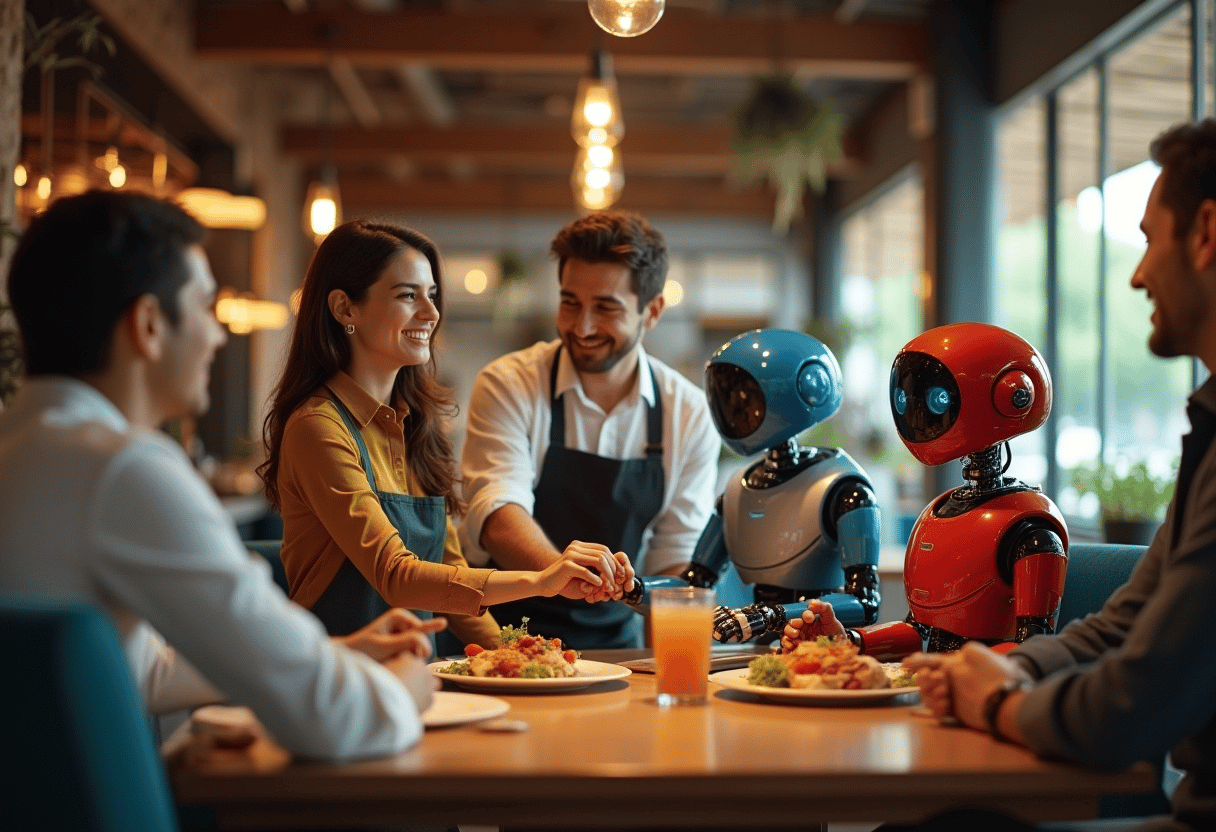
As we march into this AI-augmented future, I find myself torn in the best possible way. The tech enthusiast in me is fist-pumping: I love the potential efficiencies, the consistency, the fact that maybe I’ll never be stuck on eternal hold when calling a restaurant again. When I hear about a voice bot that can take orders at midnight and have them print in the kitchen perfectly with zero errors, I’m genuinely excited for the operator – and for my late-night cravings. When I see an AI assistant helping a barista so they don’t have to stress over the recipe for a “Grande half-caf soy caramel macchiato extra foam” and can instead spend that energy smiling at the customer, I cheer that. These tools solve real problems: they save time, cut down on mistakes, and can even boost sales and guest satisfaction. And let’s face it, some aspects of restaurant work are just grindy – if a machine can handle those and let a human do the more rewarding parts of the job, that’s a plus in my book.
But the hospitality veteran in me is also protective of what makes this industry truly special: the human touch. Restaurants are, at their core, about people serving people. The warmth, the empathy, the little moments of connection – those are hard to digitize. We call our customers “guests” for a reason; it’s an emotional, relational thing. So there’s this question gnawing at me: Can all these AI systems, no matter how slick, truly replicate the feeling that great hospitality delivers? Or will they, at best, be an efficient but somewhat soulless impersonation? One insightful commentator noted that companies like Palona are explicitly trying to imbue their AI with the “charm and care” of a seasoned staffer. That’s the goal – and I applaud it – but it’s a tall order indeed. There’s an uncanny valley in hospitality: just because a voice sounds friendly and human, it doesn’t guarantee the experience feels warm and fuzzy. I’ve had technically flawless service from a machine that left me cold, and I’ve had slightly bumbling service from a human that left me grinning ear to ear. At the end of the day, how a guest feels is the ultimate metric.
So where do we net out? I’d argue that the sweet spot is using AI to augment and assist humans, not replace them. Use the robots for what they’re great at: endless patience, memory, accuracy, speed. Use the people for what we’re great at: empathy, creativity, emotional intelligence. In practice, that could mean a hybrid model – and many operators are already leaning this way. For example, have the AI take the initial order to speed things up, but have a human double-check it and hand off the food with a genuine smile. Or let the AI answer basic phone orders, but if a conversation goes off-script (“Can I book a party of 20?”), seamlessly transfer to a human who can listen and adapt. The technology should be a tool that blends into the background of the experience, not a gimmick that overshadows it. The ideal scenario is an AI that handles the nitty-gritty flawlessly, and an empowered human team that then adds the “wow” moments on top.
We also have to stay realistic: tech can and will fail at times (servers go down, algorithms glitch). Smart operators will have backup plans and training for when the fancy AI decides to take a nap unexpectedly. Nothing’s worse than leaning so much on automation that your team forgets how to do it the old way when needed. It’s like relying on GPS and then it cuts out – you’d better still remember how to read a map (or in this case, take an order with pencil and paper!).
At the end of the day, hospitality has survived countless waves of automation – from the jukebox to the kitchen microwave to online ordering – by adapting and finding new ways to connect with guests. AI is just the latest (and maybe greatest) tool in our arsenal. I’m confident we can integrate it without losing our soul, as long as we stay mindful of that balance. In fact, if we play it right, these innovations might free us from some drudgery and let us put even more heart into serving our guests. Imagine a future where the AI handles the mundane tasks, and the humans have more time to table-touch, to personalize, to surprise and delight. That’s a future I can get behind.
So consider me a cautious optimist. I’m excited to see more baristas tapping AI assistants, more drive-thrus that never miss a “please” or “thank you,” more managers getting home earlier on a Tuesday because the forecasting AI meant they weren’t caught off-guard by the late rush. I’ll happily order from ShawnAI or whatever other friendly robot voice greets me, and I’ll probably chuckle at its quirks – just like I do with humans. And if one of these systems can make my experience faster and smoother without losing the personal feel, I might not even notice the tech at work at all (which is kinda the point). Hospitality is a funny mix of the tangible and intangible, the procedural and the emotional. AI will handle a lot more of the former; it’s on us humans to keep delivering the latter.
In closing (before I unwittingly audition for Westworld: Restaurant Edition), I’ll leave you with this: We in the restaurant biz have always been both tech adopters and tech skeptics, often at the same time. We’ll eagerly embrace anything that helps us serve our guests better, but we’ll fiercely resist anything that gets between us and those guests. The trick in 2025 and beyond is to make sure our new AI helpers stay on the right side of that line. If they do, the future is bright (and maybe a little bit sci-fi cool). You might even find yourself saying, “Thanks for dining with us – it’s been our pleasure (and our AI’s pleasure) to serve you,” and genuinely meaning it.
Have a great weekend, keep it real (even when it’s augmented), and maybe give a little “thank you” to the next drive-thru bot or auto-ordering voice you encounter – you just might get a “you’re welcome” back. After all, manners maketh the machine, too. 😉
Cheers,
Your slightly self-deprecating, definitely human narrators,
Anicia & Shane
Please let us know you feel we did with this edition: |

